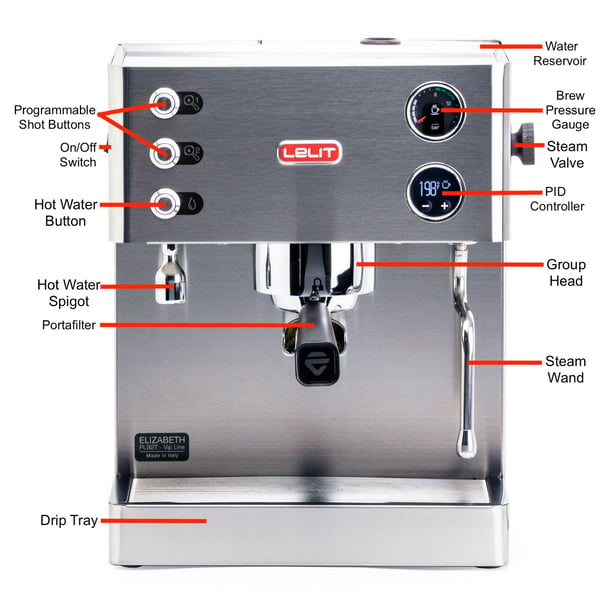Lelit Elizabeth: User Manual
Get started with your Lelit Elizabeth Espresso Machine. In this manual, you should find everything you need to operate and maintain your dual boiler espresso machine.
Please make sure to read this user manual carefully before using your Lelit Elizabeth espresso machine. If you have any other questions, be sure to contact us.
Included Accessories
- Black handle double spouted commercial portafilter
- Single basket (7g)
- Double basket (18g)
- Blind basket
- Plastic tamper
- Lelit softening and filtration cartridge
- Coffee Scoop
- Cup Riser
Water
Espresso machines have specific water requirements. Two primary considerations are filtration and hardness.
Filtration gets rid of tiny particles, such as sand or rust, in your water. If these particles were allowed to enter your machine, they could cause all manner of trouble, specifically by clogging the small valves and other parts in your espresso machine. Almost any water filter will do the job, whether it’s the one built into your fridge, a Brita, or a whole-house filter. Ensuring that this filter is replaced at the proper time will be important to ensure machine health.
Water hardness is equally important. Ideally, we want a hardness of between 35-85 ppm (parts per million). Hardness refers to the dissolved solids or mineral content in your water. Common dissolved solids are things like magnesium, calcium, and various forms of sodium. These dissolved solids are what make water, and therefore espresso, taste good. But an excess will result in scale buildup inside your machine. Scale can cause irreparable damage to your machine by clogging and forming a mineralized layer over the surface of metal parts. The process of descaling is even more damaging, eating away at the machine’s metal internals. Luckily, scale can be entirely avoided by keeping your water hardness within the recommended TDS range of 35-85 ppm.
There are numerous methods to soften your water if the mineral content has been tested to be too high for your machine.
- A Note on RO (Reverse Osmosis) or Distilled Water
Taste aside, espresso machines require some mineral content to function properly. Their steam boiler fill probes, in particular, use water's conductivity to detect the water level. With no dissolved solids, they’ll overfill, giving you water instead of steam. You must add some mineral content back in. Our recommendation is Third Wave Water packets, which are designed to offer ideal flavor and to be safe for your machine.
- Reservoir Solutions
Our first recommendation is an in-tank water softening pouch. They’re affordable, last 4-6 months, and are very effective. Another great option is to use RO water purchased by the gallon in combination with Third Wave Water packets.
The Elizabeth also includes a proprietary filtration and softening cartridge, which can easily be installed into the reservoir. To use the included filter, immerse the filter in a pitcher of water and allow the filter to soak for 3 minutes. Remove the filter from the water. Remove the small net filter from the water charge hose. Insert the water softener filter into the hose and place the filter in the tank.
No matter what solution you pick, we recommend testing the water coming from your machine’s group head every few months. City water hardness changes seasonally, and softening systems wear out. Quarterly testing will ensure your machine stays safe.
- First Time Setup with Reservoir
To begin, simply fill the reservoir with your filtered and softened water, leaving a few inches at the top to prevent spillage. Ensure that you do not spill water on top of the machine when filling, as this may cause electrical damage. When filling the reservoir, verify that the rubber/plastic water intake line is arranged so that it is fully submerged and touches the bottom of the reservoir.
Once your reservoir is filled, you can now turn on your machine with the power button located on the left side of the machine. After the boilers have filled, you’ll want to pull some water through your brew boiler and group head. Press either of the shot buttons on the front panel to activate the pump. Once at least 4 ounces of water has run through the group head, push the same button used before to stop the pump and insert your portafilter. At this point, you’ll have used most of the water in the reservoir. We’d recommend refilling your reservoir again to avoid running out of water.
Programming the PID
The Elizabeth features a PID that allows for exact control over boiler temperature. During the initial bench test process, our techs have programmed your machine to be ready to use, but it is simple to change at home if you choose to. To adjust the brew temperature, first press the minus button under the display. You’ll then see a little wrench icon below the temperature. Pressing the plus button allows you to edit this setting. You can now use the plus and minus buttons to adjust the desired brew temperature by one-degree increments. To save the setting, leave the interface alone for a few seconds until the temperature readout stops blinking. Pressing the minus button again will show you the steam boiler temperature. Continuing to press the minus button will allow you to turn program brew times, turn on/off the steam boiler, switch between Fahrenheit and Celsius, program preset pre-infusion, and access the machine’s standby mode.
Technical Details
For a complete list of technical details, please see the spec table on our product page.
Now you're ready to start pulling shots! Check out our Espresso 101 section to learn about steaming milk, latte art, our suggested starter espresso recipe, grinder dial-in tips, and much more.
